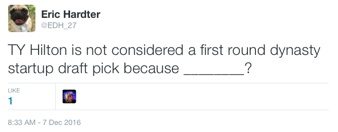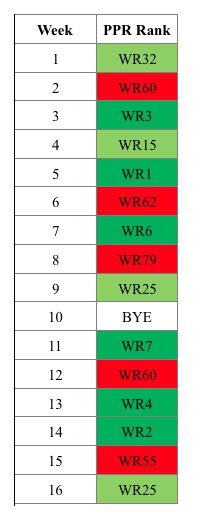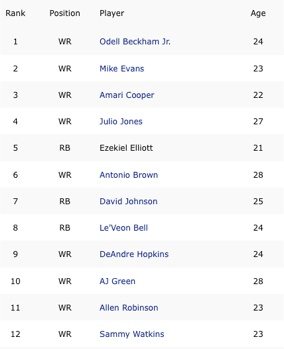TY Very Much
I’ve spoken previously about the concept of dynasty owners “being wrong until they’re right.” We saw it with former Seahawks running back Marshawn Lynch, who many cashed out on because the end was near. All he did was clear 1,200 yards and 11 touchdowns (with 23+ receptions to boot) in four straight years in 2011-2014, before his body finally gave out and he retired following the conclusion of the 2015 season. Yes, ultimately owners were “right,” but if they cashed out after 2012 they missed two years of elite level production.
Heck, we saw the opposite with his protégé, Christine Michael, who was completely useless for three years (and three teams) before having a few good games early in 2016, only to fade back into irrelevance. If you rode the lightning early you won a few games, but can you imagine if you cashed out on the hype? You could’ve undoubtedly scored a 2015 first round rookie pick after 2014, thrown a dart, and achieved a ton of fantasy production. The brief stretch earlier this season didn’t make you right, and you missed a plethora of opportunities to stop being stubborn and admit defeat.
[am4show have=’g1;’ guest_error=’sub_message’ user_error=’sub message’ ]
Even more recently, we’ve seen examples like Doug Baldwin and Emmanuel Sanders. They weren’t highly drafted and don’t have prototypical size, so their recent “breakouts” weren’t taken seriously. Yet Baldwin is on his way to polishing off his second straight WR1 year, while Sanders has defied poor quarterback play to achieve his third straight 1,000-yard season. But both can still be had in the fourth round or later, according to the December ADP. Father Time will eventually catch up (Baldwin is 28 and Sanders 29), at which point owners will be “proven right” again, as if the past few years never happened.
A more extreme case is Colts receiver TY Hilton. Despite having an excellent collegiate resume where he led his team in receiving all four years, having a reasonably strong draft status (third round), performing well in his rookie season (50/861/7), playing with the man regarded as the top dynasty quarterback (Andrew Luck), being relatively young (27), and performing as a top fantasy asset the past few years, he still doesn’t seem to get the respect he deserves. Though he’s still the 16th player taken overall, I can’t understand why he’s not a surefire first rounder.
A few weeks ago, I polled the Twitterverse to see what other dynasty owners thought, with the following query:

The responses I received included the following:
- He’s short (x3)
- There are 12 better choices (x3)
- Indy has a lot of mouths to feed / Donte Moncrief
- He’s too consistent (Writer’s note: I imagine this was tongue in cheek)
- There are 12 wide receivers I would take before him
- See reasons assigned to Randall Cobb three years ago
- There’s no reason to believe he won’t make it to round two
With regards to size, there’s nothing to say – he’s short. I don’t see why this is an impediment, but I’ve never been one to care much about things like age and stature. As for there being too many mouths to feed, Moncrief just concluded his third year with under 1,500 career yards, Phillip Dorsett has been a bust through two years, and the tight ends are largely streaky.
The Cobb comparison boggles my mind – Hilton isn’t a slot receiver, and has surpassed 1,000 yards every year he’s played except his rookie season. At this point it’s fair to assert that Cobb is a one-year wonder who benefited from a massive Aaron Rodgers campaign and Jordy Nelson taking away the defenses’ attention. Apart from being short, they have nothing in common – Cobb is closer to a rich man’s Tavon Austin than he is to Hilton.
For the rest of the argument, I’m here to change your mind. TY Hilton should be considered a first round pick.
I’ll start with his yearly statistics, shown below:
| Year | Targets | Receptions | Yards | YPR | Touchdowns | PPR Rank |
|---|---|---|---|---|---|---|
| 2012 | 91 | 50 | 86.1 | 17.2 | 7 | WR31 |
| 2013 | 138 | 82 | 1083 | 13.2 | 5 | WR19 |
| 2014 | 130 | 82 | 1345 | 16.4 | 7 | WR11 |
| 2015 | 135 | 69 | 1124 | 16.3 | 5 | WR23 |
| 2016* | 144 | 85 | 1353 | 15.9 | 6 | WR5 |
*Through 15 games
Hilton was a mid-range WR3 as a rookie, which is no small feat. From there he continued his ascendancy to a low-middle WR2 as a sophomore, and then a WR1 as a third-year pro. The obvious hiccup occurred in year four, when Hilton regressed to a low-end WR2, his worst finish since his rookie season. The obvious caveat here is that Luck only played seven games, and Hilton still eclipsed 1,100 yards. Through 15 games in 2016, Hilton picked up where he left off in 2014, and is now a high-end WR1.
Continuing, Hilton continues to procure a large percentage of his team’s work, as shown in the table below:
| Year | Target % | Reception % | Yard % | Touchdown% | AIR |
|---|---|---|---|---|---|
| 2012 | 14.49 | 14.75 | 19.68 | 30.43 | 1.37 |
| 2013 | 23.71 | 23.43 | 27.40 | 21.74 | 1.06 |
| 2014 | 19.67 | 20.00 | 26.57 | 16.67 | 1.13 |
| 2015 | 21.81 | 19.44 | 28.62 | 19.23 | 1.07 |
| 2016* | 26.52 | 24.57 | 32.45 | 20.00 | 1.02 |
*Through 15 games
Throwing out his rookie season, Hilton has achieved a high volume of targets (at least 19.7 percent every year), receptions (at least 19.4 percent every year), and yards (at least 26.6 percent every year). He’ll never be a huge touchdown scorer, which can cause many in the fantasy community to sour on a player, but you can do a lot worse than ~20 percent per year. Perhaps most importantly, he’s spiking in targets, receptions and yards in 2016.
I’ve also included Hilton’s AIR scores (proportion of a player’s PPR points relative to team totals, divided by his number of targets relative to team totals), which show that he’s been an above average performer every year in the league. His rookie score stands as the outlier, but it’s important to note that one of the better indicators for a receiver’s fantasy viability is his rookie year efficiency. Hilton has obviously dipped since then, which correlates to a diminishing touchdown percentage (based on targets) – and while I’ll forever argue against scores as it relates to valuing fantasy performers (it’s the floor versus ceiling debate), it’s impossible to ignore that adding six points to a target undeniably alters a player’s AIR score. Hilton has scored one-fifth of his team’s touchdowns, but six scores on 144 targets remains a low pace. However, given that his volume has increased, I’m okay with the AIR score of 1.02, as heavy targets can typically yield lower results.
I also want to take a step back to 2015. This is when Hilton dropped off a bit in the rankings due to Luck’s injury, but his AIR score of 1.07 remained above average. It’s nothing to write home about, but it does bring up the concept of “QB-proof” receivers. This year has shown that even stud pass catchers like DeAndre Hopkins and Allen Robinson are not immune to poor play under center. Even last year, when Ben Roethlisberger was injured, Antonio Brown struggled mightily with Michael Vick at the helm. That Hilton still functioned as a WR2 while receiving bottom-basement play from the ancient Matt Hasselbeck should mean a lot more than it does to the dynasty masses.
Finally, Hilton has achieved both consistency and a high-end ceiling in 2016, as shown in the table below highlighting his weekly fantasy finishes:

Hilton was a weekly WR3 or better in 10 of 15 weeks, a top-25 WR in 9 of 15 weeks, and most incredibly, he was a top-seven weekly receiver a whopping seven times. Essentially, he’s doing a better job of booming than what his boom/bust ADP twin, Brandin Cooks, was drafted to do. His floor is a smidge more prominent than I’d prefer (red highlights), but more often than not he’ll perform as an elite asset versus tanking your lineup.
So circling back to the initial premise I sought to prove, let’s take a look at the current first round of dynasty startups:

I won’t argue for Hilton’s inclusion amongst the top eight players, as I believe their return on investment is locked in for fantasy stardom. The lone exception to me is Raiders pass catcher Amari Cooper, who has been proven to be extremely volume dependent his first two years, but I recognize I’m on an island here. That said, I’d absolutely trade Cooper for Hilton+ right now. But I digress – let’s move on down the list beyond them:
DeAndre Hopkins – I spoke to Hopkins’ inability to transcend poor quarterback play earlier. The truth is, his first three years barely surpassed those of Hilton’s, and his fourth year letdown was worse than Hilton’s. I won’t argue against taking Hopkins here, but it’s much closer than it appears.
AJ Green – I’m actually completely fine with someone going Green. Much like Hilton he’s been the model of consistency, and he’s only a year older.
Allen Robinson – I love A-Rob. In fact, some might call it an irrational love. But his rookie year wasn’t as good as Hilton’s, and he hasn’t built on a phenomenal 2015. He’s a few years younger, but he’s also tied to a much more uncertain situation. At this point, I’d lean Hilton.
Sammy Watkins – Here’s where the “upside versus track record” debate comes to the forefront. I’m a big fan of Watkins’ talent, but the fact is he’s now missed 11 games over the past two seasons (conversely, Hilton has only missed two games in five seasons), and was nicked up for a large portion of year one. Watkins proved an elite ceiling over the tail end of 2015, but he hasn’t built on it. Again, I’d go Hilton here pretty easily.
Now of course, there’s more to crafting a dynasty opinion than what the numbers say. Many may prefer some of the above players, due to age or perceived ceiling. Obviously I don’t agree, and believe Hilton deserves a spot amongst dynasty’s elite. He’s proven an ascending trajectory, is the top dog on one of the league’s best offenses, and functions as a consistent player with a top-end ceiling. If your league-mates want to ignore these facts and let Hilton slip to you at a discount, make sure to tell them “TY very much!” after you make your pick.
Find me on Twitter @EDH_27
[/am4show]
- Dynasty Fantasy Football Mailbag: Is Kendre Miller Valued Unfairly? - April 17, 2024
- Forgotten Dynasty Veterans: Bottom Tier - April 9, 2024
- Dynasty Fantasy Football Mailbag: How Much Should You Factor in Off-Field Issues? - April 9, 2024


































































